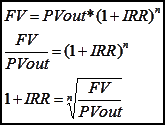- Home
- Case Studies
- Project Selection Case
A PROJECT SELECTION CASE
Published: 2014-03-27
Last updated: 2022-03-18
The following project selection case puts the rather theoretical introduction given in sub-section Project Selection into the context of a realistic situation. It is based on a question that reached us for our Q & A section. A quick scan encouraged us to create this sub-section.
We explain the selection procedure step by step, using some basic mathematics, which you can transfer to other, similar situations.
Starting point
Our company is considering to invest into one of three projects, X, Y and Z, with the following key figures:
| Project X | Project Y | Project Z | |
| As cash outflow for each project, we have only the initial investment at the beginning of each project | 10.000 | 10.000 | 10.000 |
| Project revenue, or Future Value of the project, FV | 11.770 | 28.750 | 17.939 |
| Project Duration, in number of accounting periods (in this case, in years), n | 1.0 | 3.0 | 1.2 |
| Interest Rate, r, in % per year | 0.1 = 10% | 0.1 = 10% | 0.1 = 10% |
We can only choose one project, due to limited resources.
Step 1: Calculation of the net present value
The present values refer to the beginning of the project, the point in time of the investment. Cash outflow is 10 Mill. USD for each project, paid at the beginning of the project. Therefore, the present value of cash outflow, PVout is 10 Mill. USD for each project.
In order to calculate the respective present value of cash inflow, PVin, of each project, we use the formula

In this formula we use the future value or revenue of each project in order to calculate PVin.
For the calculation of the respective net present value (NPV) of each project, we then use
Here are the results for our project selection case:
| Project X | Project Y | Project Z | |
| Present Value of cash outflow, PVout | 10.000 | 10.000 | 10.000 |
| Future Value, FV | 11.770 | 28.750 | 17.939 |
| Present Value of cash inflow, PVin | 10.700 | 21.600 | 16.000 |
| Net Present Value, NPV | 0.700 | 11.600 | 6.000 |
Thus, we might choose project Y because it has the highest net present value, NPV = 11.6 Mill. USD.
Step 2: Calculation of the internal rate of return
The internal rate of return (IRR) of a project is a theoretical interest rate which we calculate based on the assumption, NPV = 0.
This means PVin – Pvout = 0, or consequently PVin = PVout.
With the formula for PVin above, but now with the IRR instead of the real interest rate r, we obtain

(For the mathematics behind this formula, please refer to the annex below.)
Inserting all the figures of our project selection case, we get
| Project X | Project Y | Project Z | |
| FV | 11.770 | 28.750 | 17.939 |
| PVout | 10.000 | 10.000 | 10.000 |
| n | 1.0 | 3.0 | 1.2 |
| Internal rate of return, IRR | 17.7% | 42.2% | 62.7% |
With these results, we should choose project Z – and we are in a dilemma: Shall we make our decision based on the highest net present value, NPV, or the highest internal rate of return, IRR?
Step 3: Benefit cost ratio, payback period and other aspects
For the calculation of the respective benefit cost ratio (BCR) and the payback period (PP) of each project, we use

and

In our project selection case, we get these results
| Project X | Project Y | Project Z | |
| Total cash outflow, PVout | 10.000 | 10.000 | 10.000 |
| Total cash inflow, FV | 11.770 | 28.750 | 17.939 |
| Present Value, PVin | 10.700 | 21.600 | 16.000 |
| n | 1.0 | 3.0 | 1.2 |
| Average per period cash inflow | 11.770 | 9.583 | 14.949 |
| Benefit Cost Ratio, BCR | 1.07 | 2.16 | 1.60 |
| Payback Period, PP | 0.850 | 1.043 | 0.669 |
Project Y has the greatest benefit cost ratio, the project with the shortest payback period is project Z, which leads us to the same dilemma as with the comparison of net present value and internal rate of return. This should not surprise us: NPV and BCR both relate to PVin and PVout, where PVin is the total cash inflow discounted by the interest rate r over the project duration n. In contrast, IRR and PP are based on the non-discounted future value FV, only “averaged” by the project duration n (in different ways though, n-th root and simple average).
In order to come to a conclusion in our project selection case, we have to analyze other aspects as well:
- Creation of value: NPV or BCR measure the expected value created by a project, the company’s or shareholders’ benefit. IRR or PP are financial figures only, which are not suitable to predict the actual value creation.
- Project content and results: Are the project results and processes for creating those results innovative and, thus, worthwhile to undertake the project and make the investment? Do we need the project results in order to secure the technological future of our company?
- Project risk: Every project contains risk which we need to evaluate and hold against the expected profit. By definition, calculations of NPV, BCR, IRR and PP do not contain risk estimates. Risk values should rather be evaluated independently.
Without further information about the project results and processes and corresponding project risk values, our recommendation in this project selection case is to select the project with the highest expected value creation, that is project Y with NPV = 11.6 Mill. USD or BCR = 2.16, predicting the highest benefit for our company or shareholders.
Annex: Derivation of the formula for IRR
We mentioned above that IRR is the interest rate that corresponds to
NPV = 0
 How to calculate IRR, (1)
How to calculate IRR, (1)We also know:
 How to calculate IRR, (2)
How to calculate IRR, (2)Therefore, we have
 How to calculate IRR, (3)
How to calculate IRR, (3)We convert this equation
 How to calculate IRR, (4)
How to calculate IRR, (4)Finally, we obtain
 How to calculate IRR, (Result)
How to calculate IRR, (Result)35+ templates, tools, and checklists in one set
To save you time in your daily work as a project manager, I packaged more than 35 project management templates, tools, and checklists into one zip file.
- You un-zip it, and you get all items in formats you can edit to your requirements.
- They strictly contain only standard functionality and no macros or other code.
- You are allowed to use your logo.
or click here for more info.
Return to Project Management Case Studies
Return from Project selection case to Home Page
|
|
|


Your Comments
Have your say about what you just read! Leave me a comment in the box below.